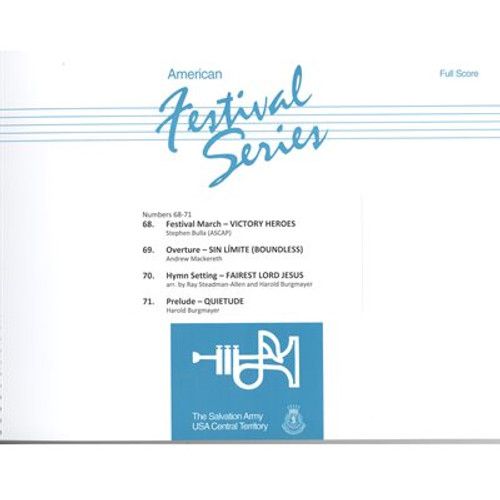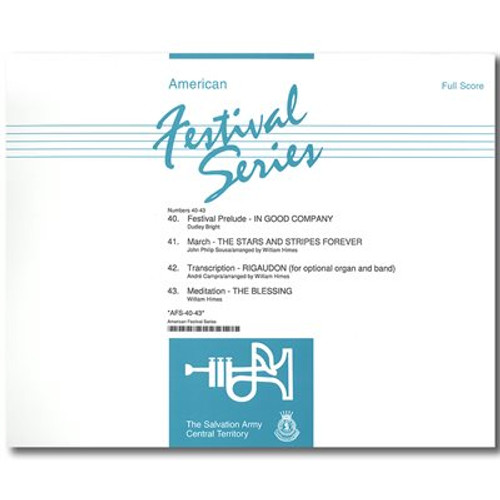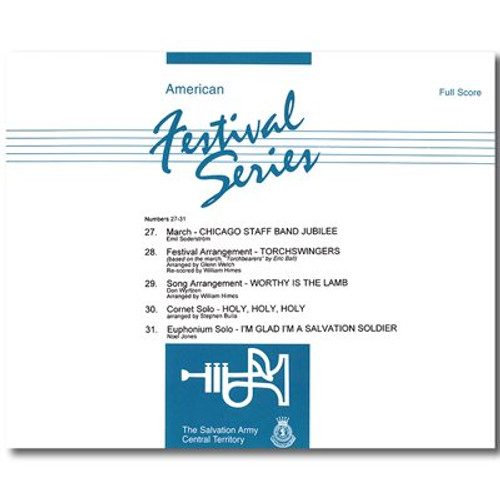Product Description
October 2019 No. 59-62
Brian Bowen, Editor
Dr. Harold Burgmayer, Music Secretary, USA Central Territory
This edition of American Festival Series brings together four varied items which will be useful for any brass band. The Sousa march Power and Glory, as transcribed by Steve Kellner, features the hymn Onward, Christian Soldiers. Pathway of Hope by William Himes, O.F. provides the option of performance as a continuous selection of as individual presentations of any of the three contrasting settings. When I Survey, from the pen of Olaf Ritman, is a warm, elegant setting for solo trombone based on the folk song O Waly, O Waly. This edition concludes with William Gordon's majestic setting of God Be With You, based on the Vaughan Williams' hymn tune Randolph. [Notes are by Dr. Harold Burgmayer, with the exception of the notes for Pathway of Hope by the arranger William Himes.](view series guide)
59. March - Power and Glory John Philip Sousa, arr. Steve Kellner Notes 60. Pathway of Hope William Himes Notes 61. Trombone Solo - When I Survey (O Waly, Waly) Olaf Ritman Notes 62. God Be With You (Randolph) Ralph Vaughan Williams, arr. William Gordon Notes
Produced by The Salvation Army - Central TerritoryMarch - Power and Glory
Program Note:
Sousa's original title of this march was March of the Mitten Men, named after Thomas Mitten, owner of both the Philadelphia transit system and Willow Grove Park outside Philadelphia. At the turn of the 20th century musical celebrities would perform in the park bandstand each summer. The march was later renamed Power and Glory and is one of only two Sousa marches known to use a church hymn, in this case, Onward Christian Soldiers. The march has been used for years on the annual Easter concern of the United States Marine Corps Band, of which the arranger, Steve Kellner, was a member.
Note to the Conductor:
This March went into public domain in January 2019, giving The Salvation Army the opportunity to publish this transcription for brass band.
Beginning to bar 38: Establish a steady tempo and a light approach overall. In contrast, the section commencing at bar 22 should be played with plenty of verve. Be sure to observe the mezzo forte dynamic at bar 30 and the sforzandos that follow.
Bars 39-71: The trio melody, introduced in euphoniums and baritones, should be played with light-hearted lit giving a push, rather than a hard attack, to the accented notes. The scale figures in the flugel (cued in solo cornet) and soprano should be well-aligned and measured. Again, carefully follow all the specific dynamic details.
Bars 72-103: The hymn tune Onward, Christian Soldiers is introduced in a simple chorale form using solo cornets and trombones, requiring a sustained style at a hushed dynamic. The flugel (cued in solo horn) and soprano cover the ends of phrases. Be sure to maintain a sustained piano from bars 88 to bar 96. From there the style is poco marcato with the full band growing from piano to mezzo forte, leaving room for a rollicking fortissimo at bar 98.
Bars 104-end: Here the trio melody in cornets and euphonium is combined with Onward, Christian Soldiers in the trombones. As the dynamics lessen into bar 128, be sure the hymn tune is still hard. The march finishes with a grand presentation of the chorus of Onward, Christian Soldiers undergirded by a steady moving bass line.
On a historic note, John Philip Sousa was a great admirer of Salvation Army bands, and said, "If you want to know one of the very good reasons why the world needs bands, just ask one of the Salvation Army warriors who for years have marched, carrying the message of the Cross, through the back alleys of life. Let me tell of the armies of men who have been turned toward a better life by first hearing the sounds of a Salvation Army band. The next time you hear a Salvation Army band, no matter how humble, take off your hat."Pathway of Hope
Program Note:This colorful selection uses three songs of contrasting idiom to portray a progression of the human condition from despair to triumph:Pathway of Hope takes its name from a social services ministry innovation initiated under the leadership of Commissioners Paul and Carol Seiler during their tenure as territorial commanders of the USA Central Territory 2010-2016. The mission is to help families break the generational cycle of poverty and lead them to self-sufficiency through employment, housing, education. Its success quickly spread throughout North America and now is adapted and implemented internationally.
- Situation: hopeless ("Sometimes I feel like a motherless child.")
- Solution: hopeful ("Reach out and touch... a spirit in despair")
- Strategy: hope-filled ("Storm the forts of darkness, bring them down!")
Note to the Conductor:
Introduction: The tempo should be unhurried, with a strong sense of the 12/8 compound meter in this soulful setting.
Bars 9-17: The trombone soloist is encourages to tastefully add any jazz stylings appropriate to the idiom and mood of what is one of the saddest themes of human despair ("Sometimes I feel like a motherless child.") The usual cautions apply for a supportive, background accompaniment.
Bars 18-25: While the full band adds to the intensity of the mood, be sure to hold something in reserve for the weight and power of the wailing second verse at 26. ("Sometimes I feel like I'm almost done.")
Bars 35-43: Although there is no change of tempo, note the directive to conduct bars 35-37 in 6 (as in 6/4 time) before returning to the 12/8 meter at bar 38. The meter again changes at bar 42 but the tempo remains the same until the poco accelerando in the following bar.
Bars 42-77: This gentle waltz should be straight forward, warm and lyrical. A study of selected verses from this lesser known song will help guide its interpretation:Bars 78-116: As this theme continues in the low brass, muted cornets should emulate the light legato texture of violins while the staccato style in the basses replicates the more rounded sound of pizzicato string bass.
- Reach out and touch a soul that is hungry,
- Reach out and touch a spirit in despair,
- Reach out and touch a life torn and dirty,
- A man who is lonely��if you care!
- ?
- Reach out and touch a friend who is weary,
- Reach out and touch a seeker unaware,
- Reach out and touch, though touching means losing
- A part of your own self��if you dare!
Bars 117-138: The brief pick-up snare drum roll (with slight crescendo) quickly changes to a militant style as the horns introduce the battle song, Storm the forts of darkness with the exhortation from cornets and trombones to "pull down the devil's kingdom where'er he holds dominion." The music gradually builds in volume and speed to bar 139.
Bars 139-208: This extended setting is the most technically demanding portion of the selection. Again, careful proportioning of dynamics is key here.
Bars 209-end: With the end in sight, the tempo begins to slow to a dramatic unison in the final bar.Although this is a more extended work (approximate duration: 9:00), the inclusion of optional introductions and endings provides added usefulness of presenting singular performances of these three songs as follows:
Sometimes I feel like a motherless child: Beginning to optional ending at bars 39-40.
Reach out and touch: Bar 42 to optional ending at bars 110-113.
Storm the forts of darkness: Begin with snare drum roll (can be a pause) one beat before 117. Play to end as written.Trombone Solo - When I Survey
Program Note:
This beautiful setting for solo trombones and band of the folk song O Waly, O Waly is often associated with the words of Isaac Watts:Note to the Conductor:
- When I survey the wondrous cross
- On which the prince of glory died
- My richest gain I count as loss,
- And pour contempt on all my pride.
We are pleased to present this sensitive setting as it was initially conceived for solo trombone. Written for the Amsterdam Staff Band's 2005 tour of the United Kingdom, it was later adapted as a feature for trombone ensemble, at the request of Salvationist Publishing & Supplies, where it appears in 2009 as General Series 2059.
We are grateful to SP&S for kindly giving permission to publish this solo version in the American Festival Series. Of this work, the arranger, Olaf Ritman writes: "I consider this song my personal testimony."
Beginning to bar 12: The accompaniment, particularly at the opening and closing of the piece, is atmospheric, with suspended muted chords supporting the rubato trombone solo. The judicious use of percussion (chimes, bass drum and suspended cymbal) will add to the color and mood. Be sure to cue the chimes at bars 3 and 6.
at bar 4, a clear downbeat cure for the bass drum will help clarify tempo following the soloist's pause. Also give attention to the muted sforzando in cornets and trombones in bar 8.
Bars 13-52: Following the ritardando at bar 12, it is essential for the conductor to establish the correct tempo at bar 13, allowing the soloist lyrical freedom and the ability to sustain long phrases as the tune begins at bar 16. The descending scale gesture at bar 39 should be measured, yet not overstated.
Bars 53-74: There is a slight slowing of tempo as soprano, flugel and horns take the theme while cornets, trombones and euphonium adding countermelody.
Bars 75 to end: Returning to the opening tempo, it will again be helpful to give clear cues for the chimes, bass drum and triangle from bars 75 to the end.
[Note: This solo can be heard on the Chicago Staff Band recording,Kurios, performed by Brett Tolcher]God Be With You
Program Note:
The tune Randolph, by preeminent English composer Ralph Vaughan Williams was first published in 1906 as a setting of Jeremiah Rankin's hymn, of which the first verse reads:This three verse setting is an arrangement of Salvationist William Gordon.
- God be with you till we meet again;
- By His counsel guide, uphold you,
- With His sheep securely fold you;
- God be with you till we meet again.
Note to the Conductor:
William Gordon's stunning four verse setting of Randolph progresses from the quiet simplicity of unison cornets and with each succeeding verse builds to a magnificent organ-like finale.
Gratitude is expressed to the publisher and copyright holder, Oxford University Press, for granting permission to publish this brass setting in the American Festival Series.
Beginning to bar 9: A ceremonial snare drum roll is the sole accompaniment to the cornets opening unison rendering of the tune.
Bar 10-17: The mellow instruments (flugel, horns, baritones and euphoniums) provide a beautiful change of color here with 2nd horn, baritones and euphonium seamlessly adding harmony.
Bars 18-26: A two beat snare and bass drum roll signals the entrance of the cornets and trombones in a more brilliant third verse setting. Here the bass trombone is essential (cued in Eb bass). Bring out the rising soprano cornet line from bar 22.
Bar 27 to end: A dramatic percussion roll precedes the "open pipes" organ like sounds of the final verse at bar 27. Be sure to observe the swell in bar 30, followed by a dramatic decrescendo before building to the final climatic chords. Avoid any tendency to overblow while striving for the full sonorities of this majestic finale.
[Note: this setting is especially effective when performed as a benediction "in the round" with players grouped by sections surrounding the audience.]







